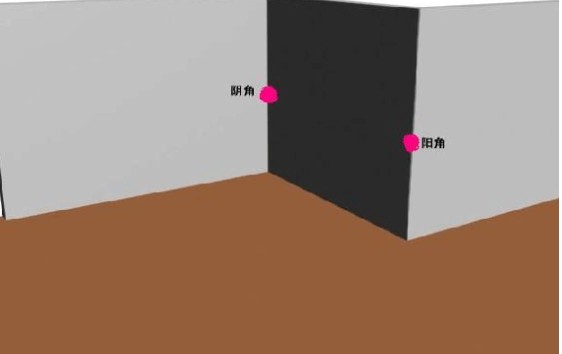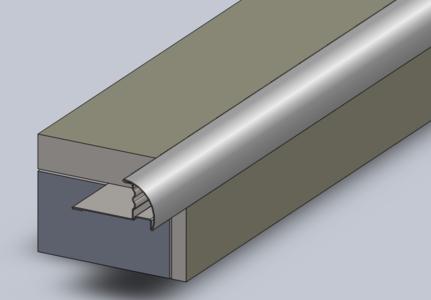Anyone who has renovated the house knows that during the renovation process, there will be an outward lobe formed by tiles and tiles. This is the tile 's outside corner . Ordinarily , the corners of tiles need to be treated, because most of the corners are assembled when the tiles are assembled in a zero-time process and are easily damaged. In addition, because it is an outwardly protruding corner, it is also easy to collide. So how to deal with tile angle ? Follow us to find out.

Tile angle treatment methods ---- sealing edge <br><br><br><br><br><br><br><br><br><br><br><br><br><br><br><br><br><br><br><br><br><br><br><br><br><br><br><br><br><br> The function of the edge strip is to solidly seal the cross-section of the sheet to avoid damage to the sheet caused by the environment and moisture in use, as well as to prevent the volatilization of formaldehyde in the sheet, so as to achieve the effect of decorative beautification.
Tile corner treatment method - grinding 45 ° angle <br> This is the most traditional method of processing, both tiles are ground 45 °, and then they are diagonally attached. But at the same time, there are also problems. There is no cement inside the corner of the tile, so it is very easy to break. In addition to some mud bricklayers, the chamfered corners do not form a regular pattern. In the future, they will encounter thermal expansion and contraction, and cracks will easily occur here.
Tiles angle treatment method - Yangxian <br> The so-called Yangjiao line, also known as Yangjiao line shuts or Yangjiao. A decorative line that is used as a corner treatment of ceramic tiles with a 90° angle, with a base plate as a surface, a 90° fan-shaped arc surface on one side, made of pvc. aluminum alloy or stainless steel. The Yang angle line is divided into the Yang angle and the Xiaoyang angle, which are adapted to tiles of 10mm and 8mm thickness, and are more than 2.5 meters in length. Yang angle line is widely used due to its advantages such as simple installation, low cost, effective protection of tiles, and reduction of the collision hazard due to the 90 degree convex angle of tiles.

Category <br> Aluminum profile Aluminum profile of the basic material is divided into three: pvc, aluminum and stainless steel, the former uses more, the latter due to the single color, so use less.
1, PVC ---- PVC profile of ceramic series (PVC material is a plastic decorative materials, is short for polyvinyl chloride materials, Polyvinyl Chloride, referred to as PVC) in the domestic market profile of ceramic wide range of popular, the amount of Large, low-cost, and wide-spread, the building materials market across the country can basically be seen. PVC defects are thermal stability and impact resistance, corrosion resistance, and poor oxidation resistance. Either hard or soft PVC is susceptible to brittleness during use.

2, aluminum alloy - aluminum alloy series tile angle line main alloying elements are aluminum, copper, silicon, magnesium, zinc, manganese, secondary alloying elements are nickel, iron, titanium, chromium, lithium and so on. Aluminum alloy has low density, but high strength, close to or more than high-quality steel, good plasticity, can be processed into a variety of profiles, has excellent electrical conductivity, thermal conductivity and corrosion resistance, widely used in industry, the amount of use is second only to steel .
3, stainless steel - stainless steel series tile angle line popularity due to high prices and far lower than the first two, stainless steel Yangjiao line according to the appearance is divided into openings, sealing two, material customized according to customer needs. With resistance to air, steam, water and other weak corrosive media and acid, alkali, salt and other chemical etched characteristics.
Advantages and Disadvantages of Yangjiao <br> Advantages: It can be used without chamfering. In the future, there will be no opening or collapse of porcelain due to the problem of deformation of the wall. Since the corners are rounded, there will be no scratching.
Disadvantages: Material in general, the use of long-term color will appear yellow, there are scratches, and tile color can not be unified, the appearance of a little worse.

How to use the tile angle line
1. Use three nails to fix the corner line at the installation place so that the corner line of the tile is parallel to the wall. (Note: When the corners of the sun corners are fixed, the space required for connecting the tiles to the other side of the corners is the same as the thickness of the tiles used to connect the corners of the tiles.)
2. Lay the tile adhesive or cement on the corners of the tiles, and attach the tiles to keep the rounded surface of the tile corner line close to the tile joints.
3, Shop the other side of the tile, close the corner line with the tile, keep the contact between the corner line and the tile is smooth and seamless.
4, tile laying is good, the tile corners and arc surface wipe clean, the installation is complete.
Xiao Bian suggestions: Everyone in the corner of the tile when using the Yang angle is better, not only can have a protective tile, but also more secure. The above methods for processing the corners of the tiles and the classification of the Yangjiao lines are briefly introduced here. We hope to help you. For more information on this site, welcome to pay attention.
ceramic tile
Hpl Engineered Doors ,Engineered Wood Door,Engineered Oak Doors,Engineered Oak External Doors
Foshan QI'AN Fireproof Shutter Doors Co., Ltd , https://www.qianfiredoors.com